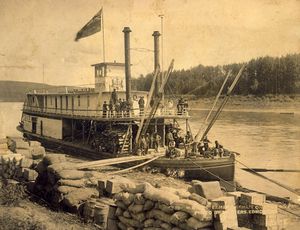Grahame (HBC vessel)
Jump to navigation
Jump to search

The SS Grahame was a wooden steamship built in Fort Chipewyan, Alberta, by the Hudson's Bay Company, in 1882, for service on the Athabaska River, lower Peace River, the Clearwater River, and the upper Slave River.[1][2] The Grahame was the first steam powered vessel in the region.[3] The engines were built in the south, and shipped overland. She was 135 ft (41.15 m) long, and could carry 140-150 tons of cargo.[4]
The vessel carried an official delegation from Canada's Federal government to negotiate treaty 8 with the First Nations in 1899.[4]
References
- ↑ Patricia Alice McCormack (2010). Fort Chipewyan and the Shaping of Canadian History, 1788-1920s (in English). UBC Press. ISBN 9780774816687. Retrieved on 2012-11-29. “The Hudson's Bay Company launched the Grahame at Fort Chipewyan in 1883 for service on the Athabasca, lower Peace, and upper Slave rivers. This ship could carry 140 tons. According to the Edmonton Bulletin, "The Indians were terribly astonished at their first sight of a steamboat". It ran from Fort McMurray to Smith's Landing, up the Clearwater River to the Methye Portage, and up the Peace River to the Vermilion Chutes.”
- ↑ Jack Danylchuk. Back on the River, Up Here (magazine), 2007. (in English) “McKay’s father had worked as a deckhand on the Grahame, a Hudson’s Bay Co. sternwheeler built in Fort Chipewyan with milled lumber, its furnace and boilers hauled north from Edmonton. Launched in 1882, the Grahame picked up freight and passengers below the rapids on the Athabasca, churning between Fort McMurray, Fort Chip and Fort Smith.”
- ↑ Fort McMurray tourism. (in English) “The Hudson’s Bay Company sternwheeler steamer, the SS Grahame, made its first trips on the Athabasca and Clearwater Rivers in 1884 marking the arrival of sternwheeler travel to the area. The trip from Athabasca for river to Fort McMurray was an adventurous and extremely dangerous one as scows and later paddle steamers had to traverse the Grand Rapids.”
- ↑ Jump up to: 4.0 4.1 René Fumoleau. As Long As This Land Shall Last: A History of Treaty 8 and Treaty 11, 1870-1939, University of Calgary Press, pp. 11, 89. Retrieved on 2012-11-29. (in English) “Transportation in the North was further changed by the appearance in 1882 of the steamboat Grahame. Built by the Hudson's Bay Company at Fort Chipewyan, the Grahame was a 135-foot vessel capable of carrying 150 tons of freight. It travelled the Athabasca and Slave rivers between Fort McMurray and Smith's Landing (Fort Fitzgerald).”
